Klipsch Reference IV Handleiding
Bekijk gratis de handleiding van Klipsch Reference IV (24 pagina’s), behorend tot de categorie Speaker. Deze gids werd als nuttig beoordeeld door 43 mensen en kreeg gemiddeld 4.6 sterren uit 22 reviews. Heb je een vraag over Klipsch Reference IV of wil je andere gebruikers van dit product iets vragen? Stel een vraag
Pagina 1/24

REFERENCE
CENTER CHANNEL
OWNER'S MANUAL

REFERENCE SERIES
IMPORTANT SAFETY INSTRUCTIONS
1. READ these instructions.
2. KEEP these instructions.
3. HEED all warnings.
4. FOLLOW all instructions.
5. DO NOT use this apparatus near water.
6. CLEAN ONLY with dry cloth.
7. DO NOT block any ventilation openings. Install in accordance with the manufacturer's
instructions.
8. DO NOT install near any heat sources such as radiators, heat registers, stoves, or other
apparatus (including amplifiers) that produce heat.
9 . DO NOT defeat the safety purpose of the polarized or grounding type plug. A polarized plug has
two blades with one wider than the other. A grounding type plug has two blades and a third
grounding prong. The wider blade or the third prong are provided for your safety. If the
provided plug does not fit into your outlet, consult an electrician for replacement of the
obsolete outlet.
10. PROTECT the power cord from being walked on or pinched, particularly at plugs,
convenience receptacles, and the point where they exit from the apparatus.
11. ONLY USE attachments/accessories specified by the manufacturer.
12. USE only with a cart, stand, tripod, bracket, or table specified by the manufacturer, or sold
with the apparatus. When a cart is used, use caution when moving the cart/apparatus
combination to avoid injury from tip-over.
13. UNPLUG this apparatus during lightning storms or when unused for long periods of time.
14. REFER all servicing to qualified service personnel. Servicing is required when the apparatus
has been damaged in any way, such as power-supply cord or plug is damaged, liquid has
been spilled or objects have fallen into the apparatus, the apparatus has been exposed to
rain or moisture, does not operate normally, or has been dropped.
This symbol indicates that there are important operating and maintenance instructions
in the literature accompanying this unit.
This symbol indicates that dangerous voltage constituting a risk of electric shock is
present within this unit.
WARNING: To reduce the risk of fire or electrical shock, do not expose this apparatus
to rain or moisture.
WARNING: Voltages in this equipment are hazardous to life. No user-serviceable parts inside.
Refer all servicing to qualified service personnel.
CAUTION: Changes or modifications not expressly approved by the manufacturer could void the
user’s authority to operate this device.
ABOUT YOUR KLIPSCH PURCHASE
Thank you for your purchase of a Klipsch center channel. After reading this manual and
connecting your system, you will hear the result of over 55 years of stringent engineering and
class-leading research and development. Like all Klipsch products, your center channel features
Klipsch Tractrix
®
Horn-loaded Technology—the guiding design for the first Klipschorn
®
developed in 1946 and for every product that has followed. Horn-loading allows your speakers
to deliver high sensitivity, low distortion, flat frequency response and wide dispersion, which
translates to unequaled power, detail and dynamics, the hallmarks of “The Klipsch Sound.”
Please be sure to fill out the warranty card at the back of this manual or online at
www.klipsch.com so we are better able to serve you. Again, thank you for choosing Klipsch and
we hope that your speaker brings life to your music and movies for many years.
UNPACKING
The easiest way to remove the speaker from its carton is to turn the open side of the box
down so that it is resting on a table or the floor, with the flaps spread out and away. Then
pull the box straight up and off. Remove any packing material from the speaker and grille,
place it back in the carton, and store in case you ever need to ship the loudspeaker. Align
the magnetic posts on the inside of the grille with the screws on the front of the speaker
and it will snap into place.
PLACEMENT
Center the speaker directly above or below your video screen. If necessary, you can place
the speaker on a floor stand in front of and below the screen that elevates it to the correct
height. Ideally, however, the speaker’s front baffle should be flush with the front of the
screen. (See Figure 1.)
If the speaker is well above or below the ear height of seated listeners, you can improve
performance by angling it slightly to compensate. Included with the speaker is an adjustable
foot that you can screw into one of two threaded inserts on the bottom of the cabinet. To tilt
the speaker down, install the foot in the insert near the back of the cabinet; to tilt it up,
install the foot in the one near the front of the cabinet. After adjusting the amount of tilt,
gently snug on the supplied jamb nut to secure the foot’s position. Cover any unused
threaded holes with the supplied flat, self stick rubber pads. Attach the dome shaped,
self-stick pads on the bottom of the cabinet for shelf protection. (See Figure 2.)
CONNECTIONS
Note: Proper connection of your speakers to your amplifier or receiver is vital to obtaining
good sound quality. Please follow these directions carefully. Sloppy connections can cause
amplifier malfunction or damage.
Figure 2
RISKOFELECTRICSHOCK
DONOTO PEN
Figure 1

Klipsch Reference Series speakers are wired internally with Bandwidth Balanced ™
M o n s t e r®Cable. Bandwidth Balanced technology employs multiple gauges of high-purity
copper wire, carefully selected and wound to ensure optimum signal transfer at all fre-
quencies. You will obtain best performance from your speakers if you connect them to
your amplifier or receiver with Monster Cable or similar quality wire available from your
dealer. We recommend that you use 16-gauge or heavier stranded copper wire. Use a
lower gauge (heavier) wire for longer runs to reduce the amount of amplifier power lost
due to the wire’s resistance.
On the back of each speaker are two sets of binding posts, one feeding the tweeter and
the other the woofers. For conventional wiring, these sets are connected together with
gold-plated metal straps, which must be removed for bi-wiring or biamping. We will
explain ordinary single-wiring first and then the alternatives. All the information regarding
single-wiring also applies to bi-wiring.
BUT FIRST: TYPES OF CONNECTORS
Bare wire. Pull the two conductors apart for about an inch and strip approximately 1/4-
inch of insulation from the end of each. (A wire stripper will simplify this, but you can use
an ordinary pocket knife to cut around and through the insulation down to the wire.) Twist
the strands of wire on each individual conductor tightly together. Loosen the nuts on a pair
of binding posts until the holes through the metal posts are exposed, then insert the bare
wire through the holes. Screw the nuts down finger-tight on the wire. Make sure that no
strands of wire are touching from one binding post to the other or to any strands from the
other conductor. Failure to observe this precaution at either end of the connection can
result in amplifier malfunction or damage.
Pins. Many pre-made speaker cables are terminated with metal pins. Loosen the nuts on a
pair of binding posts until the holes through the metal posts are exposed, then insert the
pins through the holes. Screw the nuts down finger-tight on the pins — do not overtighten.
Make sure that there is no metal-to-metal contact between the two pins or binding posts.
Failure to observe this precaution at either end of the connection can result in amplifier
malfunction or damage.
Spade lugs. Some speaker cables are terminated with U-shaped connectors called spade
lugs. Loosen the nuts on a pair of binding posts and slip the spade lugs around the metal
posts. Screw the nuts down finger-tight on the lugs and inspect to ensure they have
remained firmly in place. Make sure that there is no metal-to-metal contact between the
two lugs or binding posts. Failure to observe this precaution at either end of the connection
can result in amplifier malfunction or damage.
OTHER TYPES OF SPECIALTY CONNECTORS ARE AVAILABLE TO FACILITATE HOOKING
UP YOUR SPEAKERS. PLEASE CONSULT YOUR AUTHORIZED KLIPSCH DEALER FOR
SUGGESTIONS AND FURTHER DETAILS.
SPEAKERS TO AMPLIFIER: KEEPING IT STRAIGHT
One of the most important things about hooking up your speakers is keeping them in the
same polarity, or phase. If they are connected out of phase, bass and sound imaging will
be degraded.
The easiest way to ensure that your speakers are wired in phase is to always
connect the positive and negative output terminals on your amplifier or receiver to the
matching input terminals on your speakers: positive (“+”, color-coded red) to positive and
negative (“–”, color-coded black) to negative. (See Figure 3.)
Most pre-terminated speaker cables have color-coded connectors that make it easy
to match output and inputs correctly. If yours do not, or if you are making your own
out of paired, two-conductor wire, look for identifying marks on the insulation of the
two conductors. Normally there will be printing, a stripe or a molded ridge along one
of the conductors.
Bi-wiring - -In bi-wiring, separate cables are connected from the amplifier or receiver out
put terminals to the speaker input terminals for the tweeter and woofers. (See Figure 4.)
This results in lower electrical resistance between the amplifier and speaker than single-
wiring with the same gauge cable. In some cases bi-wiring may be preferable to single-
wiring with lower-gauge cable, which will be thicker and probably less flexible. To bi-wire
your Reference Series speakers, loosen the nuts on the binding posts and remove the
metal straps linking the woofer and tweeter terminals. Observing proper polarity, connect
one cable to the tweeter binding posts (upper) and another to the woofer binding posts
(lower). Run both cables back to your amplifier or receiver and attach them to the same
channel. (Do not, for example, attach one to an A speaker output and the other to a B
speaker output on an amplifier or receiver with A/B speaker switching.) Amplifiers may be
severely damaged if straps are not removed.
Biamping - In biamplification, the tweeter and woofers are driven by separate amplifiers
fed from the same preamplifier output. We do not recommend biamplifying any of our
speakers, since in general it will produce no benefit that could not be obtained simply by
using a single larger amplifier and may cause severe sound degradation if not done
properly. If you do biamplify, use the same model amplifier for the tweeter and woofer
sections (to prevent frequency-response errors caused by different amplifier gains) and be
sure to remove the straps linking the two sets of input terminals on the speaker. Amplifiers
may be severely damaged if straps are not removed.
BASS MANAGEMENT SETTINGS
Surround-sound receivers and processors use what is known as bass management to
ensure that low frequencies in the various channels are sent to speakers that can handle
them well and away from small speakers that cannot. Any of the Klipsch Reference Series
center-channel speakers can be set to in your receiver or processor’s speaker setupLarge
menu if necessary. But if your system includes a good powered subwoofer or floorstanding
left and right front speakers, you probably will get better overall performance by using the
Small setting for the center.
CARE AND CLEANING
The only thing you should ever need to do to your speakers is dust them occasionally.
Never apply any abrasive or solvent-based cleaner or any harsh detergent. You can clean
the grilles with the brush attachment of a vacuum cleaner.
Figure 3
Figure 4
Product specificaties
| Merk: | Klipsch |
| Categorie: | Speaker |
| Model: | Reference IV |
Heb je hulp nodig?
Als je hulp nodig hebt met Klipsch Reference IV stel dan hieronder een vraag en andere gebruikers zullen je antwoorden
Handleiding Speaker Klipsch

19 Augustus 2025
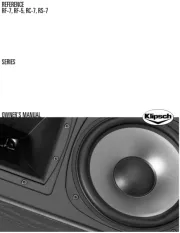
18 Augustus 2025
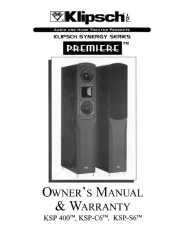
5 Juli 2025

5 Juli 2025

4 Juli 2025

4 Juli 2025

4 Juli 2025

17 Juni 2025
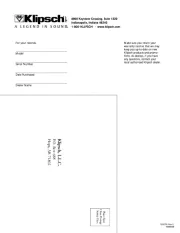
23 Mei 2025

23 Mei 2025
Handleiding Speaker
- Jam
- Nyne
- DAS Audio
- Swissonic
- Digitech
- Quad
- Laser
- Toshiba
- Ecler
- LG
- Elvid
- SpeakerCraft
- Strong
- MOOOV
- REL Acoustics
Nieuwste handleidingen voor Speaker
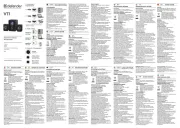
16 September 2025

16 September 2025

16 September 2025
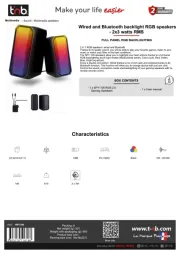
15 September 2025

15 September 2025

15 September 2025

15 September 2025

15 September 2025

15 September 2025

15 September 2025